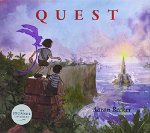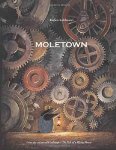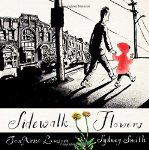I must confess that other than being able to recognize American Gothic, until recently I did not know much about Grant Wood's art. I did not know his story either. I was therefore very keen to read and review today's picture book title, which provides readers with a very unique, partially true, tale about Grant Wood's life. The story is touching and sweet, and it piqued my interest so much that I then went online and read about Grant Wood some more.
Grant and Tillie Go Walking
Illustrated by Sydney Smith
Picture Book
For ages 5 to 7
Groundwood Books, 2015, 978-1-55498-446-6
Grant Wood lives on a farm, and many days he goes walking
with Tillie the cow. Tillie is happy with her lot in her life. She has a
comfortable home, plenty to eat, and she has Grant. Unfortunately, her human
friend is not happy. Grant is an artist at heart and he feels that he belongs
somewhere where he will find “more excitement,” a place like Paris where French
artists create their works of art.
And so Grant
leaves his farm life and travels to Paris with his friend Marvin. One evening
the two artists climb to the top of the Eiffel Tower and see the city lying
below them, “lit up like fireworks.” Grant no longer wears his farm overalls.
Instead, he dons city clothes and a beret. He grows a beard and spends many
hours talking to other artists in cafes.
Grant and Marvin
paint outdoors, creating paintings in a style that is new and exciting.
Marvin’s creations sell quickly, but Grant’s do not. For some reason he is not
able to connect with Paris in a meaningful way, and when he tries to paint a cow
– something that is familiar to him - that does not work either.
Back at home, on
the farm, Tillie is missing Grant terribly. She loses interest in her food, and
she does not go for walks anymore because she does not have Grant to show her
the way. Tillie grows sad and thin, and Grant’s family members do not know what
to do to help her.
In this
delightful picture book Monica Kulling weaves together fact and fiction to give
readers a heartwarming story about an artist who has to leave home to find out
what kind of an artist he is. Children will be delighted to see how Grant and
Tillie both get something priceless from their relationship.
In an author’s
note at the back of the book readers will find further information about Grant
Wood and his art.



















